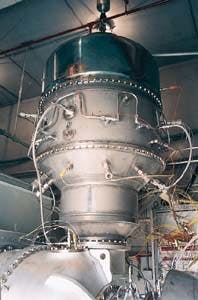Tests of catalytic-combustion technology show low emissions
J. Charles Solt, James C. Schlatter
Catalytica Combustion Systems Inc.
Mountain View, Calif.
Full-scale testing of the Xonon emissions-reducing combustion technology continues on a Kawasaki M1A-13A engine in Tulsa. The engine has achieved more than 1,100 operating hr and 220 cycles of start-up/shut-down (Fig. 3).Turbine-inlet temperatures of 1,900-2,000° F. are required to produce energy, depending upon the turbine design. Combustion of fuels, however, occurs at temperatures greater than 2,800° F.
At these temperatures nitrogen and oxygen combine to produce nitrous oxide (NOx), a U.S. Environmental Protection Agency criteria pollutant that contributes to the formation of ozone.
Impact on natural-gas pipeline operations
Because gas turbines are used to drive compressors, NO x regulations will also affect pipeline operators. Specifically, there are two federal programs under development that will significantly impact both existing and new gas turbine pipeline compression stations:- Ozone Transport Assessment Group (OTAG) has recommended regulatory changes to prevent attainment areas from negatively impacting downwind non-attainment areas.
- National Ambient Air Quality Standards revisions signed by President Clinton last June will tighten the standards for ozone and particulate matter.
A flameless, catalytic combustion process, Xonon, developed by Catalytica Combustion Systems Inc. (CCSI), Mountain View, Calif., combusts fuels at less than 2,400° F.
Two full-scale tests and another on an actual turbine in the field have indicated that Xonon consistently achieves NOx emissions of <3 ppm while maintaining optimum operating conditions in the turbine.
In November 1996, CCSI received its first commercial contract for Xonon when the City of Glendale, Calif., agreed to retrofit a Pratt & Whitney FT-4 turbine with Xonon at its Grayson power plant. The system will be delivered in early 1999.
GE announced its intent in June 1997 to market the Xonon system to its installed base of gas turbines worldwide. In December 1997, Enron Ventures Corp. announced it will invest $30 million to help accelerate Xonon's commercialization.
NOx-control technologies
The amount of NO x produced in a combustion process depends on the maximum temperature attained at any point in the combustor and on the total time at this temperature ( Fig. 1 [53,368 bytes]).A typical gas-turbine combustor would have a gas residence time in the range of 10-100 ms, depending upon the combustor design. To minimize NOx formation, it is necessary to reduce the average temperature of the combustor and to eliminate hot spots.
Hot spots are small regions where a high fuel/air ratio results in high local temperatures. Eliminating them eliminates the major cause of high NOx levels, as shown by the rapid rise in NOx level as the temperature increases.
During the last 20 years, scientists have been working to develop technologies that reduce NOx emissions while maintaining optimum temperatures and turbine performance. Standard diffusion-flame combustors produce NOx in a range of 100-200 ppm, levels prohibited under current U.S. federal and state regulations.
Dry controls, in which more air is used in the primary combustion zone than is necessary to burn all the fuel, were initially used to lower the peak temperature and reduce NOx formation. But these reduced NOx by only 10-20%.
Wet controls, in which water or steam is injected into the primary combustion zone with the fuel, were introduced to reduce peak flame temperature and NOx formation. Water and steam increase power output but increase maintenance costs.
And the greatly increased fuel consumption and steam required for steam injection usually result in a net fuel-rate increase and also produce carbon dioxide (CO) and unburned hydrocarbons (UHC) of 50 ppm.
Lean premix, in which fuel and air are premixed before they enter the combustor, was then introduced. With this approach, most gas-turbine manufacturers today guarantee NOx levels of 15-25 ppm; a few have guaranteed lower levels.
Most are experiencing problems with combustion noise, vibration, and deterioration. Lean premix can also substantially increase CO and UHC.
Selective catalytic reduction (SCR) is also commonly used today to reduce NOx, typically by 80%. In SCR, NOx reacts with an injected reducing agent, usually ammonia. SCRs are relatively expensive and use toxic metals which deteriorate with use and must be treated as a toxic waste upon disposal.
Catalytic combustion
A major challenge has been the difficulty in ignition over a wide range of mixture (air and fuel) inlet temperatures corresponding to the compressor discharge temperature at various engine loads. Also, no one had developed catalyst substrate materials capable of withstanding surface temperatures close to adiabatic combustion temperatures for long periods of operation.The Xonon combustion system carries out combustion so that formation of NOx is prevented while low CO and UHC levels are achieved. The system is contained within the combustor of the gas turbine which consists of four sections (Fig. 2 [51,081 bytes]):
- The preburner for start-up and acceleration of the engine and for adjusting catalyst inlet temperature, if required
- The fuel injection and fuel-air mixing system. This unit injects the fuel and mixes it with the main air flow to provide a uniform fuel-air mixture to the catalyst.
- The Xonon catalyst module in which a portion of the fuel is combusted without a flame to produce a high-temperature gas
- The homogenous combustion region or burnout zone, immediately downstream of the catalyst module, in which the remainder of the fuel is combusted and CO and UHC are reduced to low levels. This process also is flameless.
Partial combustion within the catalyst produces no NOx. Between the preburner and the homogenous combustion downstream of the catalyst, the system produces only 1-3 ppm NOx because the combustion occurs at a uniformly low temperature.
The system is contained in the combustor and is not a process for clean-up of the exhaust that leaves the gas turbine. Instead, it prevents NOx from forming.
The catalyst module incorporates a chemical thermostat that acts to limit the catalyst temperature even at very high fuel/air ratios, so that the catalyst temperature is significantly below the combustor outlet temperature, allowing the use of a metal substrate.
Xonon enables the combustor to produce the high outlet-gas temperatures required for modern gas turbines. But the catalyst operates at a relatively low temperature that minimizes the stress on the catalyst and achieves good durability for the overall combustor system.
In lean premix combustors, fuel and air are premixed to minimize the peak combustion temperature. The fuel-air mixture has a much higher combustion temperature in the lean premix combustor, however, because a conventional flame must be generated and sustained at the high gas velocities present in the lean premix combustor.
The higher combustion temperature results in the higher levels of NOx. If more air is mixed into the fuel in a lean premix system to reduce the NOx level further, the flame becomes unstable and combustor noise and vibration result.
In the Xonon system, the fuel-air mixture is so diluted that it would not burn in a conventional flame. In addition, the Xonon catalyst is designed to combust only a portion of the fuel, providing control of the gas-outlet temperature from the catalyst module.
The Xonon system is applicable over a wide range of combustor outlet temperatures, including advanced turbine designs. Tests have shown that even at combustor outlet gas temperatures of 2,700° F. (1,500° C.), envisioned for the next generation of turbines, the NOx level was only 2 ppm.
Full-scale tests
Development of the Xonon combustion system began with laboratory tests on small-scale catalysts at atmospheric pressure. Since then, the combustors as large as 8 mw have been operated successfully in manufacturing tests facilities. 1 2Most recently, Xonon technology has been demonstrated on an operating turbine-a 1.5 mw Kawasaki M1A-13A machine.
Three successful tests conducted on Xonon have addressed the primary challenges historically faced by catalytic combustion and the emissions and operational challenges associated with other combustion systems.
General Electric
Testing was completed in June 1996 in a catalytic combustor system test stand developed by GE for its MS9001E gas turbine, in cooperation with CCSI and Tokyo Electric Power Co. The MS9001E combustor operated with a full-load firing temperature of 2,021° F. (1,105° C.) and a combustor exit temperature of about 2,174° F. (1,190° C.).Experimental data were obtained over a range of test conditions from full speed no-load to base-load simulation. The continuously recorded data included flow rates, inlet and exit temperatures and pressures, dynamic pressures, and emissions.
Emissions targets were met both at simulated base load and part load (78%) test points. These were: baseload-3.3 ppm NOx, 2 ppm CO, and 0 UHC; part-load-5.3 ppm NOx, 8.5 ppm CO, and 1.2 ppm UHC.
Flameless catalytic combustion is not susceptible to the instabilities and dynamics that can occur in lean premixed systems. Thus, a catalytic combustor operates quietly, as observed in the GE tests.
Measurements of the dynamic pressure at a full-load test point in the GE tests resulted in an overall rms level of 0.46 psi (3.2 kPa), which is an order of magnitude below typical levels in lean premixed systems. The system also operated with a pressure drop through the reactor of about 2.6%.
The results supported the feasibility of installing this technology in an operating turbine system, which is currently in progress. The objective is a minimum 1-year catalyst life.
Solar
Full-scale tests were performed in 1997 at Solar Turbines Inc., San Diego, on a single-can catalytic combustion test stand as part of Phase III of the U.S. Department of Energy's Advanced Turbine System (ATS) program. ATS seeks to develop a high-thermal-efficiency industrial gas turbine with ultra-low emissions (<5 ppm nox, <10 ppm co, and uhc at 15% o2) over the 50-100% load range.System start-up and operation to 50% load were accomplished with a conventional lean-premixed (LP) fuel injector. At 50% load, the system changes from LP operation to catalytic operation. A medium pressure ratio (< 9 atm) recuperated thermodynamic cycle (thermal efficiency 40%) was used.
The gas turbine was operated to keep the combustor inlet temperature relatively constant between 50 and 100% load.
The tests demonstrated the feasibility of obtaining ultra-low emissions over the 50-100% load range using variable geometry control. NOx emissions <3 ppm were measured at all test points. to meet co and uhc emissions goals of <10 ppm, the air flow into the catalyst was modulated with a variable geometry valve.
The catalyst wall temperatures varied 1,610-1,718° F. (1,145-1,210° K.) and were less than the desired maximum temperature of 1,831° F. (1, 273° K.). The relatively uniform temperature measurements verify the homogenous fuel-air profiles at the catalyst inlet. The effects of a well-mixed gas mixture at the catalyst exit also were seen in relatively uniform combustor-exit temperatures.
Start-up and part-load operation of the system with a lean-premixed fuel injector were demonstrated.
Kawasaki
Full-scale operational tests are ongoing on a Kawasaki M1A-13A engine with Xonon. While the previous tests were conducted on test-stands, the Kawasaki tests being conducted in Tulsa are the first full-scale tests conducted on an actual operating turbine engine ( Fig. 3 [14,884 bytes]).The engine has achieved more than 1,100 operating hr and 220 cycles of start-up/shut-down.
The tests have demonstrated that the turbine-inlet temperature profile can be made to be identical to that of a conventional diffusion-flame combustor. That is, Xonon was designed to match the turbine-inlet temperature and the pressure drop (DP) of a standard combustor. This design ensures no impact on turbine performance.Extensive load tests conducted on the Kawasaki engine have validated full power output and efficiency within 0.5% of a standard combustor.
A control system was developed for and tested on the Kawasaki engine. The system incorporates state-of-the-art, feed-forward and model-based control features that allow the engine to be started and accelerated to its ideal condition.
The engine has been started more than 220 times in ambient conditions that range 10-98° F. Based on current test results, the starting control algorithm has repeatedly proven to be safe for both the Xonon combustion system and the engine. As the tests continue, the starting control strategy will be further developed to cover a wider range of ambient conditions.
The Kawasaki tests have demonstrated the ability to meet emissions targets from baseload down to as low as 50% load conditions. The tests have consistently resulted in NOx emissions of <3 ppm and co and uh of <5 ppm.
Combustor dynamics also were achieved over the entire operating load range. The measured dynamics were <0.1 psi/dynamic pressure pulsation.
Regulatory factors
Under current federal regulations for nonattainment areas (areas that do not meet the ambient air-quality standards-about 85% of the U.S.), the net emissions impact for a new project (or significant modification to an existing facility) must be offset by reducing emissions at other facilities.A "significant" modification, according to 40 CFR 51.160, ranges 40-250 tons/year.
An effective NOx control technology reduces offset requirements by reducing the net increase in emissions for a power project.
Xonon also can generate emissions-reduction credits (ERCs) because it reduces emissions below levels required by regulation. Xonon also can help the facility avoid Title V costs and constraints by enabling a facility that retrofits with emissions controls to get below the Title V threshold.
Xonon results in no known adverse environmental impacts, saving time and expense for mitigation measures, monitoring, and reporting requirements.
Because Xonon is a pollution prevention technology, rather than an exhaust clean-up system, an SCR is not required. This will save an end user substantial expense.
Selecting the most effective NOx emission control technology will shorten the permit timetable and help owners/operators avoid "ratcheting" whereby they must repeatedly retrofit existing equipment to achieve increasingly stringent NOx emission standards.
References
- Schlatter, James C., et al., "Single-Digit Emissions in a Full-Scale Catalytic Combustor," Turbo Expo Paper 97-GT-57.
- Dutta, P., et al., "Design and Evaluation of a Single-Can Full Scale Catalytic Combustion System for Ultra-Low Emissions Industrial Gas Turbines," Turbo Expo Paper 97-GT-292.
The Authors
J. Charles Solt is director of regulatory affairs for Catalytica Combustion Systems Inc., Mountain View, Calif., which he joined in 1994. After joining Caterpillar subsidiary Solar Turbines Inc. in 1964, he advanced from application engineering to chief of production testing. He spent 13 years as director of regulatory affairs on energy and environmental concerns for Solar and 5 years consulting in the regulatory field. Solt holds a BS (1960) in electrical engineering from Lehigh University, Bethlehem, Pa.
James C. Schlatter is director of engineering for Catalytica, which he joined in 1980. He began his career with General Mortars Research Laboratories. He holds a BS (1967) from the University of Wisconsin, Madison, and an MS and PhD (1971) from Stanford University, Palo Alto, Calif., all in chemical engineering. At Stanford University, Schlatter was a National Science Foundation Fellow and, 1983-94, a senior lecturer in thermodynamics.
Copyright 1998 Oil & Gas Journal. All Rights Reserved.



